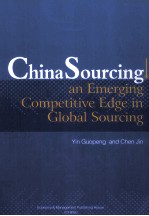

ChinaSourcingPDF电子书下载
- 电子书积分:11 积分如何计算积分?
- 作 者:YinGuopengandChenJin著
- 出 版 社:北京:经济管理出版社
- 出版年份:2011
- ISBN:9787509617281
- 页数:277 页
Part Ⅰ ChinaSourcing:Macro Level Study 3
Chapter 1 Analysis of Global Service Outsourcing Market 3
1.1 Service Globalization and Outsourcing 3
1.2 Global Outsourcing Market and Forecast 5
1.3 R&D Globalization and Opportunities in China 8
1.4 IT Services Market of United States and Japan 12
1.5 Major Outsourcing Destinations Overview 19
Chapter 2 From"Made in China"to"ChinaSourcing" 32
2.1 Economic Globalization Promotes the Transfermation of Manufacturing Industry 33
2.2 Technology Development Drives Service Transfer 34
2.3 The National Vision of Service Outsourcing Industry 35
2.4 Service Outsourcing Promotes Economic Transformation 38
Chapter 3 Comparative Analysis of China and Other Major Service Outsourcing Destinations 40
3.1 Overall Analysis and Comparison 41
3.2 Human Resources Comparison 43
3.3 Infrastructure Comparison 45
3.4 Business Environment Comparison 47
3.5 Cultural Differences 49
Chapter 4 Profile of China's Service Outsourcing Industry 52
4.1 Overview ofChina's Service Outsourcing History 52
4.2 Types ofChina's Service Outsourcing Companies 54
4.3 China's Service Outsourcing Types and Regional Distribution 62
4.4 Vendors in China's Service Outsourcing Industry 67
Chapter 5 China's Service Outsourcing Industry Policy Analysis 69
5.1 National Service Outsourcing Industry Policy Overview 69
5.2 Incentive Policy Comparison between 21 Service Outsourcing Model Cities 72
Part Ⅱ ChinaSourcing:from a Regional Perspective 79
Chapter 6 The Bohai Economic Rim(BER) 79
6.1 Beijing 80
6.2 Tianjin 86
6.3 Dalian 93
6.4 Jinan 99
6.5 Harbin 105
6.6 Daqing 110
Chapter 7 The Yangtze River Delta(YRD) 115
7.1 Shanghai 115
7.2 Nanjing 121
7.3 Wuxi 127
7.4 Hangzhou 133
7.5 Suzhou 139
Chapter 8 Pearl River Delta(PRD) 145
8.1 Shenzhen 145
8.2 Guangzhou 150
8.3 Xiamen 156
Chapter 9 Central and Western Regions 161
9.1 Wuhan 162
9.2 Chengdu 167
9.3 Xi'an 172
9.4 Nanchang 177
9.5 Hefei 182
9.6 Changsha 188
9.7 Chongqing 194
Chapter 10 Study on the Location Advantages and Division of Labour of the China Service Outsourcing Model Cities 200
10.1 A Theoretical Inquiry of the Location Advantages of the Model Cities 203
10.2 The Empirical Analysis of the Location Advantage of the Model Cities 206
10.3 Conclusions and Recommendations 216
Part Ⅲ ChinaSourcing:the Study on Vendors 221
Chapter 11 Business Model and Roadmap of Outsourcing Industry of China 221
11.1 Definition of Service Outsourcing and Offshore Outsourcing 222
11.2 Type of Service Outsourcing Business Model 223
11.3 The Evolving Business Models of Service Outsourcing 226
11.4 Growth of Local Service Outsourcing Providers 229
Chapter 12 Definition of High,Middle and Low-End in Outsourcing Services and the Position of Chinese Vendors 234
12.1 Division by Commercialization 235
12.2 Division by the Value Chain 237
12.3 Division by Price and Ability 238
12.4 Division by Closeness to End Clients 239
12.5 Classification of High,Middle and Low-End Services in Outsourcing 240
12.6 Position of Chinese Vendors 241
Chapter 13 Evaluation Criteria of Outsourcing Providers and Opportunities for China's Vendors 255
13.1 The Evaluation Process of Service Outsourcing Providers 256
13.2 Advantages and Disadvantages in China's Service Outsourcing 257
13.3 Opportunities for China's Service Outsourcing Business 259
Chapter 14 Key Capabilities for Chinese Software Services Vendors in IT Offshore Outsourcing 267
14.1 Theoretical Background 268
14.2 Research Model Development 272
14.3 Data Collection 274
14.4 Empirical Results and Discussion 275
14.5 Proposed Future Research 276
- 《中风偏瘫 脑萎缩 痴呆 最新治疗原则与方法》孙作东著 2004
- 《水面舰艇编队作战运筹分析》谭安胜著 2009
- 《王蒙文集 新版 35 评点《红楼梦》 上》王蒙著 2020
- 《TED说话的力量 世界优秀演讲者的口才秘诀》(坦桑)阿卡什·P.卡里亚著 2019
- 《燕堂夜话》蒋忠和著 2019
- 《经久》静水边著 2019
- 《魔法销售台词》(美)埃尔默·惠勒著 2019
- 《微表情密码》(波)卡西亚·韦佐夫斯基,(波)帕特里克·韦佐夫斯基著 2019
- 《看书琐记与作文秘诀》鲁迅著 2019
- 《酒国》莫言著 2019
- 《管理信息系统习题集》郭晓军 2016
- 《MBA大师.2020年MBAMPAMPAcc管理类联考专用辅导教材 数学考点精讲》(中国)董璞 2019
- 《指向核心素养 北京十一学校名师教学设计 英语 七年级 上 配人教版》周志英总主编 2019
- 《信息系统安全技术管理策略 信息安全经济学视角》赵柳榕著 2020
- 《北京生态环境保护》《北京环境保护丛书》编委会编著 2018
- 《卓有成效的管理者 中英文双语版》(美)彼得·德鲁克许是祥译;那国毅审校 2019
- 《危险化学品经营单位主要负责人和安全生产管理人员安全培训教材》李隆庭,徐一星主编 2012
- 《管理运筹学》韩伯棠主编 2019
- 《ESG指标管理与信息披露指南》管竹笋,林波,代奕波主编 2019
- 《战略情报 情报人员、管理者和用户手册》(澳)唐·麦克道尔(Don McDowell)著 2019
